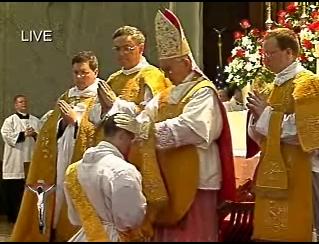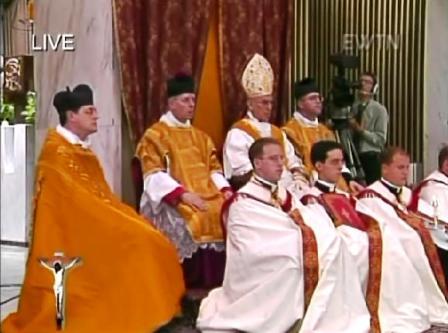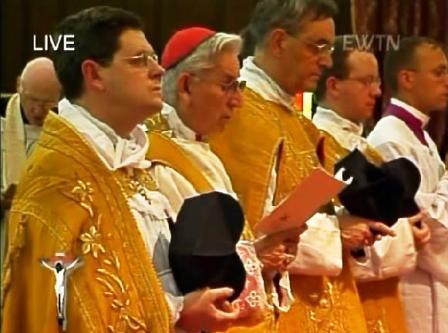This comes via Facebook from a priest reader:
What can you tell me about the use of the amice over the surplice for deacon chaplains and Assisting Priests? The AP at my first Mass wore the amice that way.
There isn’t really too much to say.
There are a few occasions wherein there may be an assistant priest, such as when a bishop pontificates or for the first three solemn Masses of a newly ordained priest. The assistant does certain things with, for example, the book and especially in the case of the newly ordained, makes sure he doesn’t make a grave mistake.
In this screen capture you can see an assistant priest to the left, in the cope.

Again… the AP is on the left, though he has his cope properly closed over his knees so that you cannot see the cassock. The deacon "chaplains" sitting with the Cardinal in this shot have their surplices.


He dresses in his cassock, with a surplice (or rochette if can wear one). He put on the amice over the surplice and then the cope. I think the idea is that it is he not quite a sacred minister in the sense that the celebrant and deacon and subdeacon are. He is sort of in between being an MC and a sacred minister. The amice? Dunno… that’s just the way it is.
You might be interested to know that in olden times, in processions, priests and deacons used to wear the vestment of their rank, chasuble or dalmatic, but over the surplice, not over an alb, also with the amice over the surplice.


































I think the amice over the surplice is a vestige of the practice of canons donning one over their rochet, since it would ordinarily be the canons assisting at a pontifical mass, and that is where peolple would see an assistant priest. My understanding is that the rochet was never allowed to be shown uncovered, it is either partially or fully covered at all times (e.g. mantelleta, mozzetta, cappa) When these vestments were not worn, it was covered with an amice or a surplice. Simple priests, following suit, did the same with their own surplice
JGKester: That is plausible.
What role do deacon chaplains perform during the Mass? It seems interesting that they take the places of the deacon and sub-deacon of the Mass sitting next to the bishop at the throne.
Father Z: I seem to remember that early editions of the Extraordinary form Missal required ALL priests to put on a surplice immediately over his cassock before vesting for Mass. I’m assuming by inference this would also have applied to deacon and subdeacon at Solemn Mass. If I remember correctly, the practice eventually fell into disuse and was eventually removed from the rubrics.
The Caeremoniale Episcoporum prescribes it (L I, Cap Vii):
“Igitur Episcopo, officium … facturo, … ipse
[assistems presbyter] … capiet
paramenta, videlicet amictum super rochetto aut cotta, et
super eo pluviale….”
Hmmm…
This does not mean a cleric should wear a amice in this fashion whenever he wears a cope over cassock and surplice–i.e., for the liturgy of the hours or for baptisms or weddings outside of Mass?
Also, I was not aware of the expectation of the cleric pulling his cope over his knees–is that what one should do at all times one wears a cope, or is that particular to the liturgy described in the post?
I’ve got a wonderful book on Church protocol (The Church Visible by Noonan) that has pictures of various situations regarding vestiture, and that the Cardinals at Vatican II are wearing the vestment proper their rank in the Sacred College (Cardinal Deacons the Dalmatic, Cardinal Priests the Chasuble, and Cardinal Bishops the Cope) over an amice and rochet, another instance of this practice.
Fr. Fox: No, I don’t think that follows. The usual way to wear a cope is over the surplice, without the amice.
John P: Thanks for that reference for the newer form!
Is this also a relic of the amice as headgear in the liturgy that predates the biretta?
Is there some connection with religious who wear hoods, these were always covered by an amice when on the sanctuary were vestments other than just the surplus?
It is interesting that in the Dominican Ceremonial (1869) the medieval rubric that we were to put on the rochet before vesting in the amice and alb was still there–although a note says that the practice had fallen out of use generally. We did this because the approbation document of the Dominican Order defines us as canons regular, not friars and the rochet is proper to canons (among others).